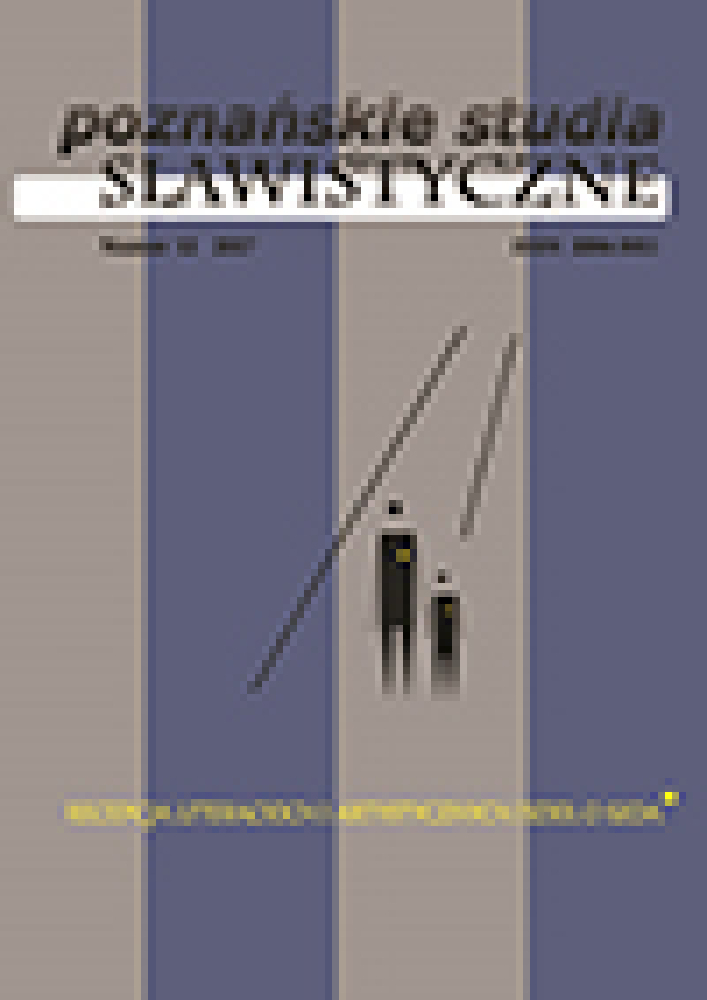Abstract
Kolář’s plays Chléb náš vezdejší and Mor v Athénách, written at the turn of the fifties and the sixties, are the examples of aestheticization of testimonies and other texts about the Shoah. Kolář’s creative path is in a way pars pro toto of artistic and literary search of many authors reacting to the experience of Shoah and to many texts describing this hecatomb. Doubt in the previous aesthetics and in the polyphonic load of words is one of the most common experiences in the second half of the 20th century – until now. The author activates memory or cultural connotations of receiver and by eliminating a factual layer that could became a psychological safety valve that distracts, focuses a viewer (reader) on the most important and by it the most difficult to bear: to the event itself.References
Bauer M., 2001, Jiří Kolář: Očitý svědek v zemi mrtvých / Očitý svědek ze země mrtvých, “Tvar” No. 14, Praha, pp. 6–7.
Brecht B., 1968, Schriften zur Politik u. Geselschaft 1919-1956, vol. II, Frankfurt, p. 204.
Butor M., 1898, Les Mots dans la peinture, Paris.
Černý V., 1992, Nástin básnické osobnosti Jiřího Koláře. Pokus o genetiku básnika abstraktního, in: Tvorba a osobnost I., Praha, p. 874.
Engelking L., 2005, Codzienność i mit. Poetyka, programy i historia Grupy 42 w kontekstach dwudziestowiecznej awangardy i postawangardy, Łódź.
Engelking L., 2007, Laleczki na sprzedaż. Zabawa w Holocaust i handel Holocaustem, Muzykalia XI-Judaica 3, , 28.06.2016.
Grodecka A., 2009, Wiersze o obrazach. Studium z dziejów ekfrazy, Poznań.
Grossman J., 1991, Horečná bdělost Jiřího Koláře, in: Analýzy, Praha, p. 364.
Hoek L.H., 1995, La transposition intersémiotique. Pour une classification pragmatique, in: Rhétorique et image, Amsterdam, pp. 64–78.
Kibédi Varga A., 1989, Criteria for Describing Word-and-Image Relations, “Poetics Today” No. 1, vol. 10, Tel Aviv, pp. 31–53.
Kolář J., 1965, Snad nic, snad něco, “Literární noviny” No. 36, vol. XIV, pp. 6–7.
Kolář J., 1985, Prometheova játra, Toronto.
Kolář J., 1986, Notre pain Quotidien a La Peste ďAthènes, trans. E. Abrams, Paris.
Kolář J., 1994, Dovětek autora, in: Dílo, vol. III, Praha.
Kolář J., 1997, Wszystkie moje kolaże brały się z moich przeżyć, trans. Z. Machej, “Literatura na Świecie” No. 7, pp. 18–34.
Kolář J., 1999, Slovník metod / Okřídlený osel, Praha.
Kolář J., 2000, Chléb náš vezdejší, Mor v Athénách, Praha–Litomyšl.
Kolář J., 2012, Naoczny świadek, trans. R. Putzlacher-Buchtová, Kraków.
Lamáč M., 1970, Jiří Kolář, Praha.
Pešat Z., 1998, Tři průhledy na poezii Jiřího Koláře, in: Z. Pešat, Tři podoby literární vědy, Praha, p. 176.
Porębski M., 1969, Modernizm i modernizmy, in: Sztuka około 1900. Materiały sesji SHS. Kraków, grudzień 1967 r., Warszawa.
Praz M., 2006, Mnemosyne. Rzecz o powinowactwie literatury i sztuk plastycznych, Gdańsk.
Snyder T., 2015, Czarna ziemia. Holokaust jako ostrzeżenie, trans. B. Pietrzyk, Kraków.
Ubertowska A., 2004, Przepisywanie Zagłady. Shoah w późnych poematach Tadeusza Różewicza, „Pamiętnik Literacki” No. 2, p. 61.
Winter A., 2011, Jiná estetika Konceptualismus a transmedialita v české literatuře po druhé světové válce, in: Česká literatura v intermediální perspektivě, Praha, p. 31.
Żukowski T., 2006, Tożsamość pod presją. Proza Adolfa Rudnickiego o Zagładzie, in: Wojna. Doświadczenie i zapis. Nowe źródła, problemy, metody badawcze, Kraków, pp. 273–309.
License
Copyright (c) 2017 Agata Firlej

This work is licensed under a Creative Commons Attribution-NoDerivatives 4.0 International License.
